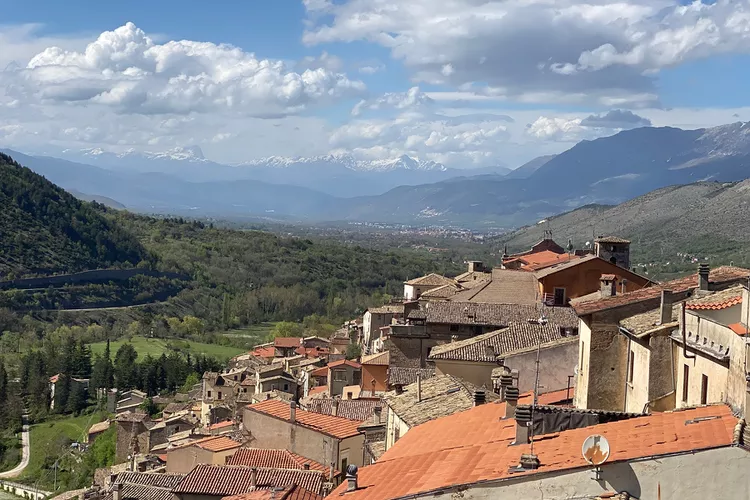Summary
Exploring the Central Apennines
From storybook towns to otherworldly landscapes, the Central Apennines is one of the most underrated destinations in Italy.
Sitting on the gentle slope of the hill above the town of Barrea, Italy, I took in the ethereal view of the golden sunrise piercing through the clouds, casting a soft glow on the mountains above the creamy blue waters of Lago di Barrea and the red roofs adorning every home. But above all else, one thing stood out: the quiet.
Located less than a two-hour drive east of Rome, Barrea is just one of 25 charming towns in the 123,000-acre National Park of Abruzzo, Lazio, and Molise in the Apennines Mountains, a range running through the length of the Italian mainland. Despite the crowded sites in the capital of Italy, about 100 miles away, this region—the central Apennines—is far less trafficked, to the extent that most locals I talked to throughout my travels couldn’t believe a foreigner was visiting.
Wildlife and Natural Beauty
The national park—the second oldest in the country, celebrating its 100th anniversary this year—is a natural paradise, primed for hiking, biking, kayaking, horseback riding, and, most importantly, wildlife spotting. After all, this region is known as the “wild heart of Italy” because of its tremendous biodiversity, with golden eagles, deer, otters, chamois, and Apennine wolves, mingling with its most cherished endemic creature, the Marsican brown bear.
:max_bytes(150000):strip_icc():format(webp)/TAL-meadow-apennines-mountains-barrea-italy-HIDDENITTOWN0922-421530bb961644089c813e66585124f3.jpg)
It was precisely the pursuit of this species, currently classified as “critically endangered,” that brought me to the area on Exodus Travels’ Rewilding the Apennines trip. The itinerary was designed to introduce travelers to the region through visits to provincial towns, like Pescasseroli (the birthplace of philosopher Benedetto Croce) and Pettorano Sul Gizio (flanked by the Monte Genzana Alto Gizio Regional Nature Reserve, a corridor connected to the national park), and to the conscious efforts made by locals working to preserve the area’s fauna.
Rewilding Initiatives
“The Italian wilderness is different,” Exodus local leader Umberto Esposito, who has written and photographed hiking guides for the region, told iBestTravel. “It still holds memories of layers of human history, both evident and concealed, among untamed mountain ranges. And that provides an incomparable example of balance and harmony.” The result, he added, is a “richer and thicker” landscape, which provides coexistence between humans and wildlife in an unmatched way.
Among the activities on the trip are visits to the Bear Smart Communities to see how that bear-to-human relationship is fostered to increase the current count of about 50 bears, as well as a hike to an overnight stay at the isolated Mountain Refuge Bisegna, with a bit of wildlife tracking while en route.
Environment and Culture
But the true delight comes from organic experiences that arise along the way. During our visit to the cobblestone-lined town of Pettorano Sul Gizio, we met with RA Art Projects’ Eugenio Vitto Massei, who invited us into his family’s ancestral home, packed with relics and photos for a peek into the Apennines lifestyle. While there, we climbed a steep mountainside to participate in the rewilding efforts, helping remove hundreds of feet of barbed wire while taking in another breathtaking view of the region with a river winding through the village.
:max_bytes(150000):strip_icc():format(webp)/TAL-stream-barrea-italy-central-apennines-HIDDENITTOWN0922-27edc0b69e914963ad7e0d99bef3d859.jpg)
During the hike to the mountain refuge, our leader Andrea De Angelis—who innately knew every inch of the trail from his dozens of trips there—veered us off course to a sprawling valley, where he recounted stories of the animals he’d seen in the area. The passion in his eyes grew as he told us of the time he saw a herd of wild boars at the bottom of the valley, and when he and his travel companions saw three wolves peeking over the ridge.
“Peering down at us confidently and staying there like kings for more than an hour made an impressive view,” he said. “But there was some more still to come. Next to the mountain pass, two unmistakable shapes perched on a white limestone cliff made such a sight. A golden eagle pair, resting for some time on the ridge and sharing the same scenery with the wolves and, of course, with the most delighted humans.”
While the animal kingdom didn’t reveal itself the day we were there, it still struck me how vast the landscape was—and how it entirely belonged to the animals.
Even without seeing the bears in their natural habitat, it was clear this was their land. But it was also apparent they needed our help. During our journey to remove the barbed wire, we came across tufts of bear fur, proving the rewilding work to be critical.
And, beyond drinking in the stunning views, I learned to appreciate the fact that taking a trip far off the trodden routes of a popular destination can not only help alleviate the impact of overtourism but can also open our minds to the magic of the places that don’t get the marquee treatment.
:max_bytes(150000):strip_icc():format(webp)/TAL-header-barrea-italy-central-apennines-HIDDENITTOWN0922-626493485a574e9089a8c1c630a7c269.jpg)
“Rome still makes an unmatched case of both landscape and architecture excellence—nevertheless, to fully understand the city’s essence and history, any demanding traveler should take their time to visit the geographic context of the mountains,” Esposito said.
As Esposito added, the quick trip from the city center takes you “amid old-growth forests landscapes, majestic mountain ranges still roamed by brown bears and wolves, making for one of the most incredibly exciting traveling experiences in Europe.”
The six-night Rewilding the Apennines tour will be offered in May and September 2023. For more information, visit exodustravels.com.




